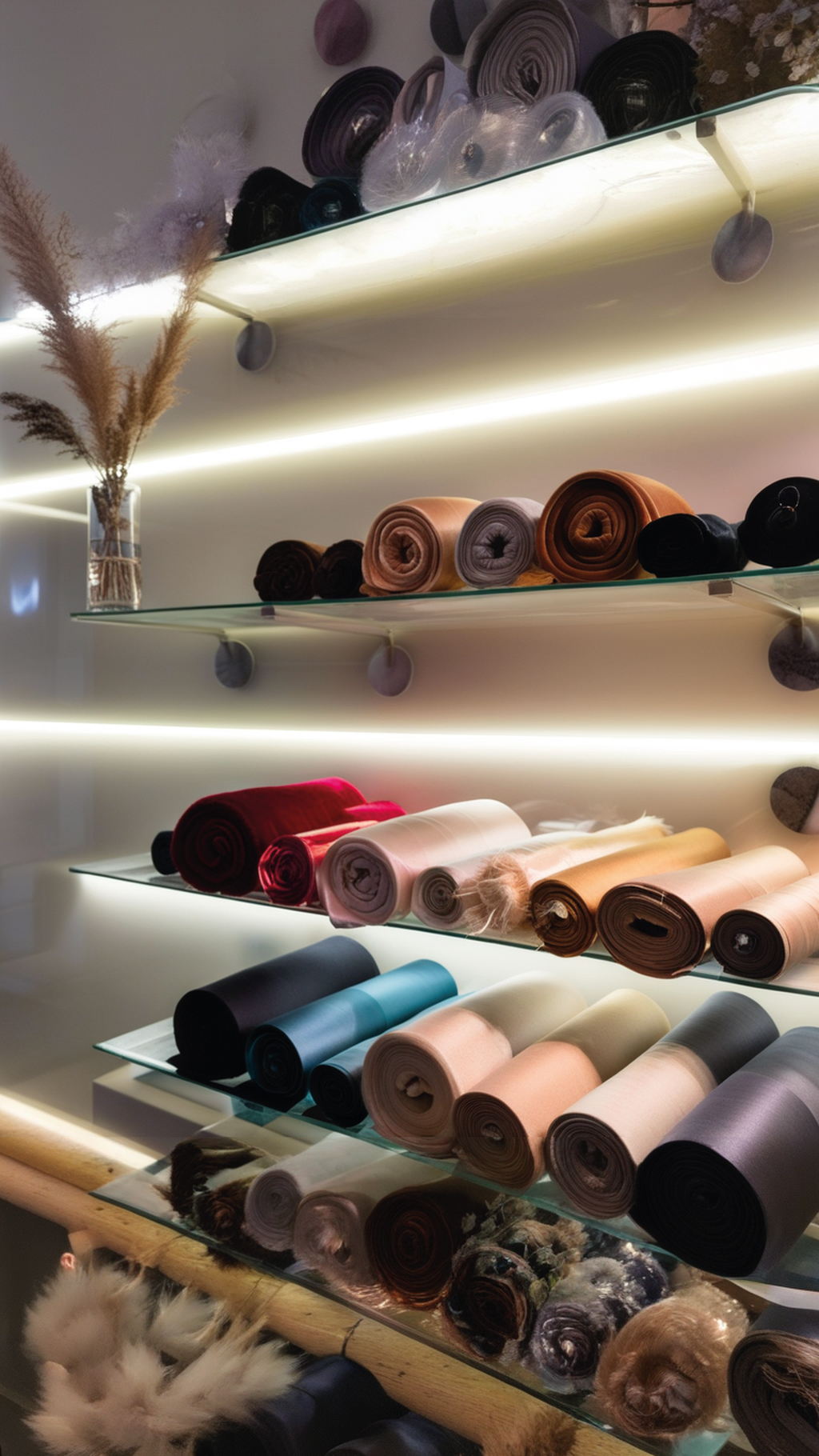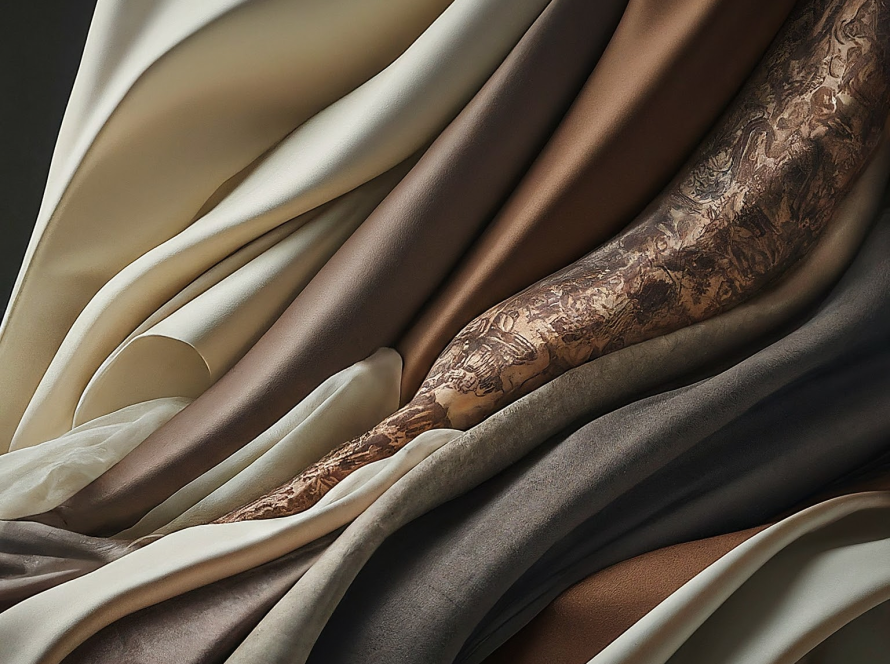
GÜVENİLİR, LÜKS KUMAŞ TEDARİĞİ
Premium Kumaş Tedariği
NOVAIST, kumaş tedariğinde nihai ortaktır ve üstün kaliteli tekstillerden oluşan geniş bir yelpazeye eşsiz erişim sağlar. Yol gösterici kaynağınız olarak geniş uzmanlığa sahip olan NOVAIST, küresel kumaş pazarında gezinmeyi sorunsuz hale getirerek ürünlerinizin mevcut en iyi malzemelerle hazırlanmasını sağlar.
Moda ve Hazır Giyim
Ev Dekorasyonu
Sürdürülebilirliğe Odaklanma

Sürdürülebilir Moda
Sürdürülebilir moda, çevresel ayak izini en aza indiren ve etik işgücü uygulamalarını teşvik eden giysi tasarımı, üretimi ve tüketimi anlamına gelmektedir. Bu hareket, geleneksel moda endüstrisinin kirlilik, atık ve işçilerin suistimali gibi zararlı etkilerini ele almayı amaçlamaktadır. Sürdürülebilir moda ve tekstil sadece bir trend değil, aynı zamanda gezegenin korunması ve adil işgücü uygulamalarının sağlanması için gerekli bir değişimi temsil etmektedir. Sürdürülebilir modanın temel ilkeleri şunlardır:
Çevre Dostu Malzemeler: Çevreye verilen zararı azaltmak için organik, geri dönüştürülmüş veya biyolojik olarak parçalanabilen kumaşların kullanılması.
Döngüsel Ekonomi: Yaşam döngülerini uzatmak için giysilerin yeniden kullanımını, geri dönüşümünü ve ileri dönüşümünü teşvik etmek.
Etik İşgücü Uygulamaları: Adil maaşların, güvenli çalışma koşullarının ve işçilere saygılı davranışın sağlanması.
Şeffaflık: Markaları kaynaklarını, üretim süreçlerini ve çevre üzerindeki etkilerini açıklamaya teşvik etmek.
Kumaş Seçiminde İşlevselliğe Öncelik Verme
NOVAIST Tekstil Kütüphanesi

Sık Sorulan Sorular
%100 keten kumaş, özellikle ilk kez yıkandığında çekmeye eğilimlidir. Ortalama olarak keten, nasıl yıkandığına ve kurutulduğuna bağlı olarak %3 ila %10 arasında çekebilir. Keteni sıcak suda yıkamak veya yüksek ısıda kurutmak çekmeyi artırabilir. Çekmeyi en aza indirmek için ketenlerin soğuk veya ılık suda yıkanması ve havayla kurutulması veya düşük ayarda tamburlu kurutma yapılması önerilir. Önceden yıkanmış keten kumaşlar genellikle daha az çeker.
Viskon ve liyosel kumaşların her ikisi de selüloz bazlı lifleri nedeniyle çekmeye eğilimlidir. Bu kumaşlar ortalama olarak ilk yıkamadan sonra %3 ila %5 oranında çekebilir. Ancak yanlış yıkandığında (özellikle sıcak su veya yüksek ısıda kurutma ile) çekme oranı %8’e kadar çıkabilir. Aşırı çekmeyi önlemek için, bu kumaşların ılık veya soğuk suda yıkanması, en düşük hızda sıkılması, asılarak kurutulması ve çamaşır kurutma makinesi kullanılmaması tavsiye edilir.
Kadife kumaş, her biri farklı bir doku ve görünüm sunan çeşitli türlerde gelir. En yaygın kadife türlerinden bazıları şunlardır:
- Ezilmiş Kadife: Kumaşın ıslakken bükülmesiyle oluşturulan buruşuk, parlak bir dokuya sahiptir.
- Streç Kadife: Daha fazla esneme ve esneklik için spandeks içerir.
- İpek Kadife: Lüks ve yumuşaktır, ipek liflerinden yapılmıştır (genellikle suni ipek ile karıştırılır).
- Vual Kadife: Kadifeye benzeyen ancak pamuk veya sentetik liflerden yapılan yumuşak, pelüş bir kumaş.
- Kadifemsi: Genellikle pamuktan yapılan yoğun ve kısa tüylü kadife.
- Kabartmalı Kadife: Tasarımların kumaşa ısı ile preslenmesiyle oluşturulan kabarık desenlere sahiptir.
- Panne Kadife: Parlak yüzeyli, düzleştirilmiş bir yüzeye sahiptir.
- Şifon Kadife: Yumuşak bir dokuya sahip hafif ve şeffaf.
- Tükenmiş Kadife (Devoré): Yarı şeffaf desenler oluşturmak için kadife parçalarının kimyasal olarak çözüldüğü desenli bir kumaş.
Evet, kumaş özellikle yıkandıktan veya yanlış kullanımdan sonra bükülebilir veya deforme olabilir. Bu sorun genellikle kesim veya dikiş sırasında düzgün hizalanmayan kumaşlarda görülür. Gevşek örgülü veya doğal liflerden (pamuk veya keten gibi) yapılmış kumaşlar bükülmeye daha yatkındır. Ayrıca, kumaş önceden çektirilmemişse veya sıcak suyla yıkanmışsa, şekilsiz hale gelebilir. Bükümü önlemek için üreticiler genellikle kumaşı stabilize etmek için sanforlama veya diğer sonlandırma işlemlerini gerçekleştirirler.
Her zaman değil. Fabrika verileri önemli teknik özellikler (çekme oranı, ağırlık ve dayanıklılık gibi) sağlarken, gerçek dünya sonuçları aşağıdakilere bağlı olarak değişebilir:
- Yıkama ve bakım koşulları (sıcaklık, deterjanlar, kurutma yöntemleri)
- Kumaş depolama ve işleme
- Üretim partisi farklılıkları
- Çevresel faktörler (nem, sıcaklık)
Özellikle kritik ürünler için seri üretimden önce kumaş numuneleri üzerinde şirket içi testler yapılması tavsiye edilir. Bu, fabrika verilerinin doğruluğunun teyit edilmesine yardımcı olur ve kumaşın gerçek kullanım koşullarında beklendiği gibi performans göstermesini sağlar.
Bu tip doğal karışımlı elyaflar, polyester içermediğinden hassas ve oldukça naziktir. Doğru kullanılmadıklarında ürün üzerinde kumaş reaksiyon verebilmektedir. Tavsiyemiz, bu ürünleri tüketecek tüketicinin öncesinde ürünün içeriği ve kompozisyonu hakkında araştırma yapması (sosyal medya, yapay zeka, kurumsal internet siteleri ve teknik tekstil blogları gibi), daha sonrasında satın alıp almamaya öyle karar vermesidir. İlgili mağazadan da bu konu hakkında bilgi alabilirler.
Ayrıca, ürünün yıkama talimatlarına göre bakımının yapılması gerekir. Eğer kumaşa fibrilasyon işlemi uygulandıysa (eskitme görüntüsü efekti), doğal içeriğinden ötürü ürün yıkandıkça eskitme efekti her yıkama sonrasında azalacak, solacak ve aslına yani efektsiz haline geri dönecektir. Dolayısıyla bu tip ürünleri alan tüketicilerin önce bu konuyu bilmeleri gerekir.
Yıkama işlemi bu tip ürünler için çok önemli olup, tavsiye edilen yıkama ise elde hassas yıkama veya çamaşır makinesinde yıkanacaksa, ürün mutlaka tersten ve tek olarak (makine içinde başka ürün olmayacak şekilde), maksimum 20-30 derecede ve 400-600 devir sıkma programında (daha yüksek sıkma devri kumaşın yapısını bozabilir), mevcut makinede bulunan en kısa program süresi seçilerek kumaşın rengine uygun sıvı deterjanla yıkanması tavsiye edilir.
Sonrasında ise kesinlikle kurutucu kullanılmadan, ürünü sererek veya askıda kurumaya bırakmak gerekir (doğrudan güneş ışığından uzak). Ürünler buharsız ve tersten ütülenmelidir. Yüksek ısı ve buhar, kumaşın deforme olmasına sebep olabilir. Bunların dışında yapılacak her türlü uygulama kumaşın yapısını bozacağından, örnek olarak ürünün yüzeyinde çizgi şeklinde izler görülebilir.




